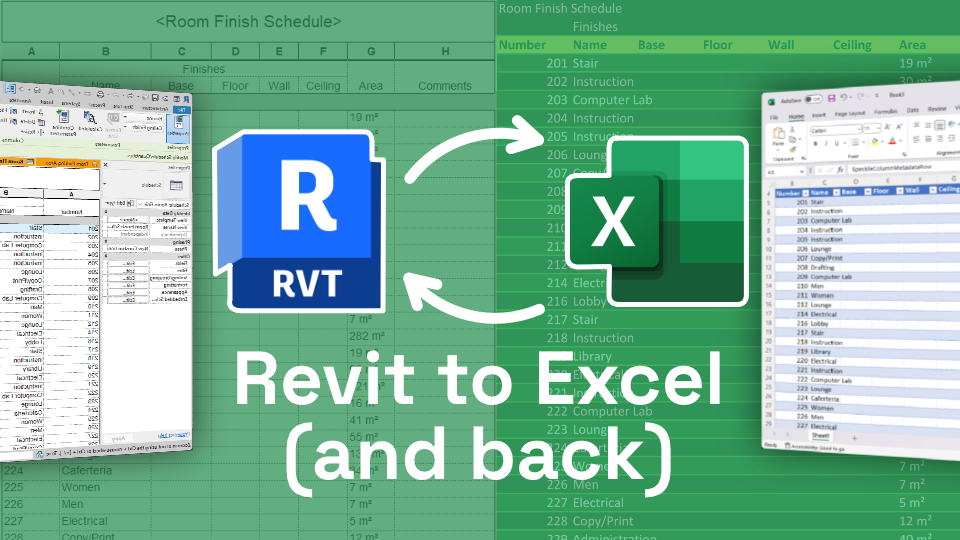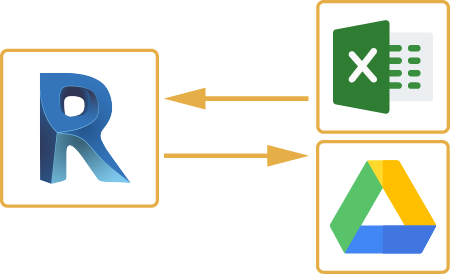Unlock New Possibilities with Innovative Revit Plugins
Wiki Article
Excel-to-Revit: A Game-Changing Operations for Architectural Layout - Introducing the Tricks
Are you tired of costs hours on architectural design? Look no more! Presenting excel-to-revit, the game-changing operations that will certainly reinvent your style process. With excel-to-revit integration, you can streamline your architectural style, unlock efficiency, and make best use of partnership within your group. In this short article, we will reveal the tricks of this powerful tool, showing you how it can transform your design projects. Prepare yourself to take your building layout to the following degree with excel-to-revit!The Power of Excel-to-Revit Integration

Visualize the ease of being able to update and modify job data in Excel, and promptly see those modifications reflected in your Revit version. No a lot more manual information entry or laborious updates. With Excel-to-Revit combination, you can save time and minimize errors by leveraging the power of Excel's solutions and functions to immediately generate exact data in Revit.
Not just does this integration enhance efficiency, however it also improves collaboration amongst team members. You can conveniently share Excel files with coworkers, who can after that import the information into their Revit versions. This promotes a smooth exchange of information and makes sure that every person is working with one of the most up-to-date data.

Streamlining Building Design With Excel-To-Revit
Enhancing building style is made easier with the usage of Excel-to-Revit (revit add ins). With this effective assimilation, you can enhance your operations and save beneficial time throughout the style procedure. By leveraging the capabilities of Excel and Revit, you can effortlessly transfer data in between the two platforms, removing the need for hand-operated data entrance and lowering the risk of mistakesExcel-to-Revit allows you to import and export information easily, enabling you to quickly upgrade and change your architectural styles. You can develop schedules, calculate quantities, and create reports in Excel, and after that move that information directly into your Revit design. This assimilation makes certain that your design information is always current and integrated, eliminating the need for hands-on updates and minimizing the opportunities of inconsistencies.
By utilizing Excel-to-Revit, you can likewise take advantage of the effective computational abilities of Excel. You can execute intricate estimations, analyze data, and automate repetitive tasks, all within Excel. Then, with simply a couple of clicks, you can import the outcomes back right into Revit, allowing you to make informed layout choices and optimize your building styles.
Unlocking Efficiency: Discovering the Excel-to-Revit Process
Maximize your performance by flawlessly incorporating Excel and Revit for an extra effective workflow. With the Excel-to-Revit process, you can unlock an entire new level of efficiency in your architectural layout procedure. By using the power of Excel's data management capacities and integrating it with the versatility and precision of Revit, you can simplify your style process and conserve useful time.One of the key advantages of this combination is the ability to import and export information between Excel and Revit. This means that you can conveniently transfer project details, such as space schedules or product quantities, from one software to the various other, eliminating the demand for hands-on data access and decreasing the opportunities of mistakes. You can also develop custom-made formulas and estimations in Excel to automate repeated jobs and do complex estimations, which can then be flawlessly integrated right into your Revit designs.
Furthermore, the Excel-to-Revit process allows for much better control and partnership in between team participants. With Excel acting as a main information hub, multiple employee can service various aspects of the job simultaneously, upgrading and sharing info in real-time. This not just improves interaction but likewise ensures that every person is working with one of the most up-to-date data, removing the risk of incongruities.
Making The Most Of Cooperation: Excel-to-Revit for Architectural Teams
By effortlessly incorporating Excel and Revit, architectural teams can considerably boost cooperation and attain more efficient style end results. When using this powerful process, you can quickly move information in between Excel spread sheets and Revit models, improving the style procedure and boosting interaction among team members. With Excel-to-Revit integration, you can effortlessly import project information, such as area routines, product quantities, and project specifications, straight into Revit, eliminating the need for manual data entry and decreasing the possibilities of errors. This seamless link permits real-time updates, guaranteeing that everybody is dealing with the most up-to-date details and staying clear of disparities in between different files.In addition, by leveraging Excel's effective calculation capacities, you can do complex estimations and evaluation on your design information, offering valuable understandings and driving informed decision-making. This combination also allows you to export data from Revit to Excel, allowing you to create thorough reports, graphes, and graphs for discussions and analysis. This collective workflow advertises effective communication and control among group members, as Excel works as a central center for data monitoring and sharing.
Overall, by accepting the Excel-to-Revit workflow, architectural groups can achieve higher degrees of collaboration, effectiveness, and precision in their style procedure. revit plugins. This assimilation empowers teams to collaborate perfectly, making certain that everybody gets on the very same page and contributing to the success of the task
Introducing the Secrets of Excel-to-Revit Combination

Among the secrets of Excel-to-Revit assimilation is the ability to take advantage of the power of solutions and estimations in Excel to drive parameters and generate complicated geometries in Revit. You can connect Excel spread sheets to Revit family members, permitting you to input data directly into the spreadsheet and have it immediately upgrade in the Revit version. This streamlines the design process and guarantees accuracy and consistency across the job.
One more key is the capacity to develop custom routines and reports in Excel, utilizing data removed from Revit. This permits you to assess and imagine project information in a manner that is not feasible within Revit alone. You can quickly produce quantity take-offs, cost estimates, and task timelines, giving beneficial understandings for decision-making and job monitoring.
In enhancement, Excel-to-Revit integration enables efficient cooperation among staff member. Multiple customers can work with the exact same Excel spreadsheet concurrently, making it much easier to collaborate and track changes. You can additionally make use of Excel's commenting function to offer feedback or connect style modifications.
Verdict
By combining the power of Excel and Revit, designers can now function more successfully, conserve time, and create much better layouts. Start incorporating excel-to-revit integration right into your building style process today and revolutionize the means you function.With just a few clicks, you can import the outcomes back right into Revit, enabling you to make informed layout choices and optimize your architectural layouts.
By using the power of Excel's data monitoring abilities and integrating it with the flexibility and accuracy of Revit, you can improve your design procedure and save valuable time.
By effortlessly integrating Excel and Revit, building teams can considerably improve cooperation and attain a lot more efficient layout outcomes. When using this effective operations, you can easily move data between Excel spread sheets and Revit designs, streamlining the design procedure and improving interaction among group members.Additionally, by leveraging Excel's effective computation capacities, import excel into revit you can execute complicated estimations and analysis on your style information, supplying valuable insights and driving informed decision-making.
Report this wiki page